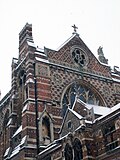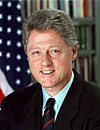Portal:University of Oxford
| Main page | Indices | Projects |
The University of Oxford portal
The University of Oxford is a collegiate research university in Oxford, England. There is evidence of teaching as early as 1096, making it the oldest university in the English-speaking world and the world's second-oldest university in continuous operation. It grew rapidly from 1167, when Henry II banned English students from attending the University of Paris. After disputes between students and Oxford townsfolk in 1209, some academics fled north-east to Cambridge where they established what became the University of Cambridge. The two English ancient universities share many common features and are jointly referred to as Oxbridge.
The University of Oxford is made up of thirty-nine semi-autonomous constituent colleges, four permanent private halls, and a range of academic departments which are organised into four divisions. Each college is a self-governing institution within the university, controlling its own membership and having its own internal structure and activities. All students are members of a college.
It does not have a main campus, but its buildings and facilities are scattered throughout the city centre. Undergraduate teaching at Oxford consists of lectures, small-group tutorials at the colleges and halls, seminars, laboratory work and occasionally further tutorials provided by the central university faculties and departments. Postgraduate teaching is provided in a predominantly centralised fashion.
Oxford operates the Ashmolean Museum, the world's oldest university museum; Oxford University Press, the largest university press in the world; and the largest academic library system nationwide. In the fiscal year ending 31 July 2023, the university had a total consolidated income of £2.92 billion, of which £789 million was from research grants and contracts.
Oxford has educated a wide range of notable alumni, including 30 prime ministers of the United Kingdom and many heads of state and government around the world. 73 Nobel Prize laureates, 4 Fields Medalists, and 6 Turing Award winners have matriculated, worked, or held visiting fellowships at the University of Oxford, while its alumni have won 160 Olympic medals. Oxford is the home of numerous scholarships, including the Rhodes Scholarship, one of the oldest international graduate scholarship programmes. (Full article...)
Selected article
The Council of Keble College, Oxford ran the college (in conjunction with the Warden) from its foundation in 1868 until 1952. The council – a group of between nine and twelve men – has been described as "an external Council of ecclesiastical worthies", as most of the members came from outside the college, and many were not otherwise linked to the university. Keble was established by public subscription as a memorial to the clergyman John Keble. The first council members were drawn from the committee whose work had raised the money to build the college. By keeping matters relating to religion and the college's internal affairs in the hands of the council, the founders hoped to maintain Keble's religious position as "a bastion of 'orthodox' Anglican teaching" against the opponents of Tractarianism. In total, 54 men served on the Council, 11 of whom were college alumni; in 1903, Arthur Winnington-Ingram (Bishop of London) became the first former Keble student to join the council. It ceased to exist after 9 April 1952, when new statutes of the college placed full management in the hands of the Warden and Fellows. (Full article...)
Selected biography
Selected college or hall
St Hugh's College was established in 1886 as a college for women by Elizabeth Wordsworth, great-niece of the poet William Wordsworth. She used money inherited from her father, who had been Bishop of Lincoln, and named the college after St Hugh, a 13th-century Bishop of Lincoln. Men were first admitted in 1986. It is based in north Oxford, between Banbury Road on the east and Woodstock Road on the west, and has large grounds. There are about 370 undergraduates and 225 postgraduates; the college is able to house all undergraduates and many of the postgraduates in buildings on the main college site for the duration of their studies. Two large lawns are used by students all year round, and the gardens are also the venue for croquet and tennis. St Hugh's is the only Oxford college with its own basketball courts. Alumni include the politicians Barbara Castle and Theresa May, the Burmese activist and Nobel Peace Prize winner Aung San Suu Kyi, the suffragette Emily Davison and the child-prodigy mathematician Ruth Lawrence. The Principal, appointed in 2007, is the Scottish lawyer Elish Angiolini. (Full article...)
Selected image

Did you know
Articles from Wikipedia's "Did You Know" archives about the university and people associated with it:
- ... that economist Barbara Ward (pictured), an early advocate of sustainable development, was the first woman ever to address a synod of Roman Catholic bishops?
- ... that Sir Albert Napier was described as the "midwife to civil legal aid"?
- ... that academic Anastasios Christodoulou was named 'Anastasios' ('Resurrection') by his parents as he was born on Easter Day?
- ... that cricket writer Gerald Howat won the Cricket Society's Golden Jubilee award for his biography of Learie Constantine?
- ... that William Wroth founded the first independent chapel in Wales in 1639, after he refused to obey King Charles' instruction to allow sports to be played on Sundays?
Selected quotation
Selected panorama
On this day
Events for 21 May relating to the university, its colleges, academics and alumni. College affiliations are marked in brackets.
|
Births
|
Deaths
|
Wikimedia
The following Wikimedia Foundation sister projects provide more on this subject:
-
Commons
Free media repository -
Wikibooks
Free textbooks and manuals -
Wikidata
Free knowledge base -
Wikinews
Free-content news -
Wikiquote
Collection of quotations -
Wikisource
Free-content library -
Wikiversity
Free learning tools -
Wikivoyage
Free travel guide -
Wiktionary
Dictionary and thesaurus















